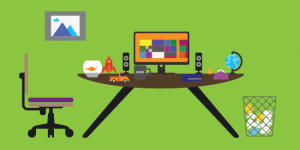 If you’ve worked in an office, you know there are often many obstacles to productivity. Whether it’s too many interruptions, a loud coworker, or just poor communication – there are things, specific to the work environment, that detract from your ability to work. Over the years, office spaces have evolved to suit modern working styles, but there are still inefficiencies that need to be ironed out. Here’s a look at where we’ve been, where we’re going, and how these changes will impact workplace productivity.
If you’ve worked in an office, you know there are often many obstacles to productivity. Whether it’s too many interruptions, a loud coworker, or just poor communication – there are things, specific to the work environment, that detract from your ability to work. Over the years, office spaces have evolved to suit modern working styles, but there are still inefficiencies that need to be ironed out. Here’s a look at where we’ve been, where we’re going, and how these changes will impact workplace productivity.
Yesterday
Ever work in a traditional office? One with doors and walls or a cubicle farm with rows and rows of semi-partitioned spaces? Does the thought of working in one make you anxious and trigger feelings of isolation and confinement. If so, you’re not alone.
In 1993 Dr. Francis Duffy and Jack Tanis wrote: “We are in danger of continuing to build offices that are more suitable for the first decades of this century than for the next.” According to Duffy and Tanis, traditional office spaces are “more capable of suffocating initiative than of stimulating invention,” and they worked toward building new physical spaces that gave employees “the maximum freedom to use all their talents.”
Today
Around that time open-plan offices, in which people work in large, open spaces with few physical barriers, were rising in popularity. The idea was that this would increase collaboration, creativity, and productivity. Open layouts are meant to encourage a sense of group togetherness and make employees feel like part of a more relaxed, creative enterprise.
|
Tomorrow
Most offices won’t revert back to traditional office spaces. Open-office layouts allow more people to work per square inch, reducing the amount of total office space needed. So how can you blend traditional and open-office floor plans to get a modern workspace appropriate for how people work today?
The key is to create an office space without barriers that can also be private. Given the increase in mobile devices used in the office, it’s important to have a flexible work environment where people can move around and work in different places. One way is having private breakout rooms where a person or a small group of people can work together. Other solutions include alcove sofas and workbays to break up an open space and provide workers with more private options.
The challenge for tomorrow will be designing a space that creates a feeling of psychological privacy but is also flexible enough that people can easily move around and collaborate. With technology enabling a more grab and go work style, we need workspaces to reflect that increased flexibility. How has the way you work changed and how has your workplace evolved (or not evolved) in response?





